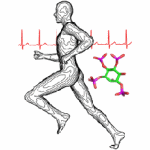Physiology
|
29 july 2011 17:24:09 |
| Receptors and effects of gut hormones in three osteoblastic cell lines (BMC Physiology) |
|
Tweet Background:
In recent years the interest on the relationship of gut hormones to bone processes has increased and represents one of the most interesting aspects in skeletal research. The proportion of bone mass to soft tissue is a relationship that seems to be controlled by delicate and subt le regulat ions that imply `cross-talks` between the nutrient intake and tissues like fat. Thus, recognition of the mechanisms that integrate a gastrointestinal-fat-bone axis and its application to several aspects of human health is vital for improving treatments related to bone diseases. This work analysed the effects of gut hormones in cell cultures of three osteoblastic cell lines which represent different stages in osteoblastic development. Also, this is the first time that there is a report on the direct effects of glucagon-like peptide 2, and obestatin on osteoblast-like cells.
Methods:
mRNA expression levels of five gut hormone receptors (glucose-dependent insulinotropic peptide [GIP], glucagon-like peptide 1 [GLP-1], glucagon-like peptide 2 [GLP-2], ghrelin [GHR] and obestatin [OB]) were analysed in three osteoblastic celllines (Saos-2, TE-85 and MG-63) showing different stages of osteoblast development using reverse transcription and real time polymerase chain reaction. The responses to the gut peptides were studied using assays for cell viability, and biochemical bonemarkers: alkaline phosphatase (ALP), procollagen type 1 amino-terminal propeptides (P1NP), and osteocalcin production.
Results:
The gut hormone receptor mRNA displayed the highest levels for GIP in Saos-2 and the lowest levels in MG-63, whereas GHR and GPR39 (the putative obestatin receptor) expression was higher in TE-85 and MG-63 and lower in Saos-2. GLP-1 and GLP-2 were expressed only in MG-63 and TE-85. Treatment of gut hormones to cell lines showed differential responses: higher levels in cell viability in Saos-2 after GIP, in TE-85 and MG-63 after GLP-1, GLP-2, ghrelin and obestatin. ALP showed higher levels in Saos-2 after GIP, GHR and OB and in TE-85 after GHR. P1NP showedhigher levels after GIP and OB in Saos-2. Decreased levels of P1NP were observed in TE-85 and MG-63 after GLP-1, GLP-2 and OB. MG-63 showed opposite responses in osteocalcin levels after GLP-2.
Conclusions:
These results suggest that osteoblast activity modulation varies according to different development stage under different nutrition related-peptides. |
| 190 viewsCategory: Physiology |
 Regulation of Caenorhabditis elegans vitellogenesis by DAF-2/IIS through separable transcriptional and posttranscriptional mechanisms (BMC Physiology) Regulation of Caenorhabditis elegans vitellogenesis by DAF-2/IIS through separable transcriptional and posttranscriptional mechanisms (BMC Physiology)Monitoring the wild black bear`s reaction to human and environmental stressors (BMC Physiology) 
|
| blog comments powered by Disqus |
MyJournals.org
The latest issues of all your favorite science journals on one page
The latest issues of all your favorite science journals on one page



